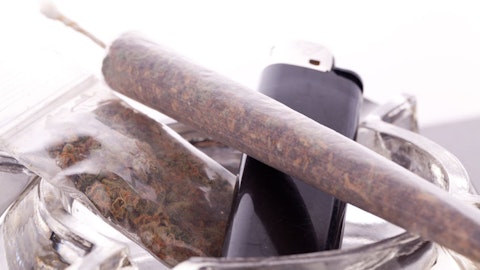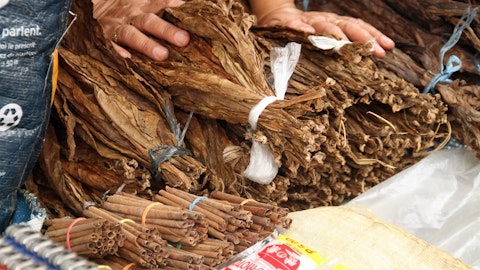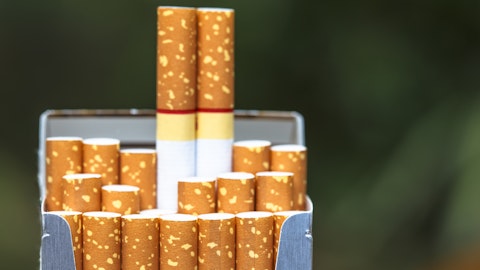British American Tobacco p.l.c. (NYSE:BTI) Q4 2022 Earnings Call Transcript February 9, 2023
Jack Bowles: Good morning everyone, and welcome to our 2022 Full Year Results Presentation. I am Jack Bowles, Chief Executive of BAT. With me this morning is Tadeu Marroco, our Group Finance and Transformation Director. I am proud to share with you today that we have reached an exciting inflection point in our transformation. Over the last few years, New Categories have rapidly become a significant part of our business and are now a strong contributor to our financial performance. As a result, last week we announced our new regional structure and management team realignment to drive us through the next phase of our transformation journey. Our presentation today will take on a new format. First, I will give some highlights of the progress.
Tadeu will take you through the details of our results, highlighting how in 2022, we continued transforming the business, delivered strong financial results, and successfully navigated a challenging macro-economic environment. Then I will talk about how we are taking BAT’s strategy to the next level, and why we are confident in bringing forward our New Category profitability target by one year to 2024, as our transformation accelerates. As usual, once Tadeu and I have taken you through the presentation, there will be an opportunity to ask questions. Before we start, I would like to take this opportunity to give you an update on the progress of the transfer of our businesses in Russia and Belarus: As we have already shared, we are working as quickly as possible to transfer the businesses in compliance with international and local laws.
We are now in advanced discussions with a joint management distributor consortium with a view to completing the transfer in 2023. Our priority remains supporting our employees in the affected areas and safeguarding their employment. Upon completion, BAT will no longer have a presence in Russia and Belarus. With that, I take it that you have all seen the disclaimer on slide two and Slide three. I am delighted to share with you today our progress and delivery against the three priorities we set out in 2019. We are, delivering a Step Change in New Categories, enabling us to bring forward our profitability target, driving value from our combustibles business, and at the same time, significantly simplifying BAT, our structure, processes and ways of working to drive greater efficiency.
Since 2018, we have grown our Non-combustible product consumer base by 30% on a CAGR basis, reaching 22.5 million in 2022 with again more than 4 million added in the last 12 months. And we remain confident on our target of 50 million consumers of non-combustible products by 2030. Over the last four years we have grown New Category revenue by a CAGR of 33% and we are confident in achieving our £5 billion revenue target by 2025, regardless of the transfer of our businesses in Russia and Belarus. Non-Combustible revenue as a percentage of Group revenue has more than doubled from 7% in 2018 to 15% today and grew by over 2 percentage points in 2022. So in just a few short years, with Vuse and glo, we have built two, one billion pound global brands.
This is an enviable performance relative to any global CPG brand. In 2022, Vuse further built on its market leadership position in vapour and delivered a 3rd consecutive year of over 40% revenue growth. glo continues to outpace global THP category growth, delivering in excess of 25% revenue growth. In Modern Oral, Velo delivered another year of over 40% constant currency revenue growth and maintained its leadership position in Europe. ESG, is at the centre of our strategy. All this is supported by a clear environmental focus, underpinned by science for each of our New Category brands and is actively contributing to our Group sustainability targets. We continue to develop and publish a substantial body of scientific evidence. And we are investing in the R&D of products that have a lower environmental impact and improved circularity.
This means we are seeking to design products that are easier to dismantle at end-of-life. Improve ways to enhance reusability and recyclability, and convert to more sustainable packaging. More broadly, as we reduce the health impact of our business, we must also drive progress across all other material ESG areas. And in 2022, we appointed Mike Nightingale as our first Chief Sustainability Officer, implemented a new Double Materiality-led approach to inform on Sustainability Agenda and continued to embed sustainability across BAT. While we recognize we have a lot more to do, we are making very good progress. In 2022, we achieved our renewable energy use targets three years early, which is why we have increased our target to 50% by 2023 — by 2030, sorry.
In addition, we are on track to reach our gender representation target across our wider workforce with women in management roles at 41%, and we are delighted to be included in the 2023 Bloomberg Gender Equality Index. Alongside this, our continued efforts have been recognized with the CDP “A” rating in climate change and inclusion in the Dow Jones Sustainability Index for the 21st consecutive year. Central to our purpose is reducing the health impact of our business. In our established markets we continue to transform at speed, with non-combustible already representing over 30% of our revenue in a total of 11 markets, where we have been most active with our multi-category strategy and we expect more markets to exceed this 30% level in 2023 as we take our transformation to the next level.
I am especially proud that since 2020, we have improved New Category contribution by nearly £700 million, while also investing over £4.5 billion. Our New Category model is now meaningfully contributing to Group results, and our progress to-date makes us confident that we will achieve Group profitability in 2024, one year early. Our transformation continues to be fueled by combustible value growth. Over the last four years we have delivered robust revenue, profit, and value share growth, while significantly reducing complexity to drive further efficiencies. We have also delivered a total of £1.9 billion of annualized cost savings over the last three years through Quantum. Nearly doubled our initial £1 billion target. Project Quantum has enabled new ways of working that are now fully embedded within BAT.
In addition, our strategy has enabled us to materially increase our free cash flow generation with four consecutive years of at least 100% operating cash conversion. As a result, we have been able to return a total of £19.2 billion to shareholders through dividends alone. Over the last four years, which is around 30% of our current market capitalization. We know that innovation and transformation is fed by a broad diversity of views and experiences. Over the last four years, we increasingly attracted new talent to BAT with over 3000 new capabilities hires focused on areas of, Science, Innovation, ESG, Digital, and Data analytics. While at the same time we have accelerated our diversity agenda, with 47% of our new hires being female. We have also improved our new hire turnover to a level well below market norms.
I am proud that our achievements are being recognized externally including most recently being certified a €œGlobal Top Employer€ for the 6th consecutive year. So we have come a long way on our A Better Tomorrow journey and I am proud of what we have achieved. Our strong momentum has continued in 2022. I will now hand over to Tadeu, who will take you through the details of our 2022 financial performance.
Tadeu Marroco: Thank you Jack. I am delighted to share more details on how we have delivered on our guidance in 2022. I am proud to say, as Jack has highlighted, that we are accelerating the Transformation of our business and delivering robust financial results while successfully navigating an increasingly challenging macro environment as we moved through the year. Our reported results were impacted by a number of mostly non-cash one-off items, including, a full-year non-cash impairment of our businesses in Russia and Belarus. A provision recognized in respect of the DOJ and OFAC investigations. And restructuring charges driven by Project Quantum. These were partially offset by VAT credits in Brazil relating to prior periods.
To better understand the key drivers of our performance, we will now focus on constant currency adjusted results, unless otherwise stated. In 2022, we delivered revenue growth of 2.3% driven by New Category growth of 37%, and a strong combustibles price mix of nearly 5%. Profit from operations was up 4.3%, driven by a reduction in New Category losses of nearly £600 million and continued Quantum savings. Altogether, we achieved a 150 basis points increase in our operating margin at current rates. This drove adjusted diluted EPS up 5.8%, or 12.9% on a current currency basis. Turning to New Categories, we delivered strong revenue growth with all three categories growing in excess of 25%, driven by share growth, innovation and Geo expansion.
This demonstrates the importance of a global multi-category strategy with strong brands and great products, in the right markets. I will now share more details on our key category drivers. Full market shares across our key markets are available in the appendix. In Vapour, we extended our value share leadership position with Vuse achieving 35.9% in the key vapour markets up 2.5 percentage points. In the U.S., Vuse strengthened its number one position reaching 40.9% value share, up 8.4 percentage points. We expect further upside in the U.S. going forward driven by existing vapour consumers switching to products that receive marketing authorization from FDA together with increased enforcement. In addition, given the excise advantage of vapour over combustibles, we see a strong runway of growth as consumers can benefit from significant savings.
In Europe, our closed system value share, excluding disposables, grew strongly, and is now over 64%. In Canada, we extended our value share leadership position growing 8.9 percentage points to around 90%. We launched the Group’s first connected Vapour device, Vuse ePod2 plus driving increased pod consumption. Through our growing scale, we are making continued progress on driving profitability in vapour reaching a positive contribution in three of the five key markets in 2022. Growth in the global vapour category has accelerated driven by modern disposables which have expanded the category. We launched our modern disposable, Vuse Go, with a premium price positioning and volumes which are accretive to our ePod platform. We have rapidly rolled out Vuse Go and are already the value share number two in the UK, France, South Africa and Germany.
In addition, we are starting to see some accelerating poly-usage with modern disposables coming from THP, which creates a significant opportunity for us. We are approaching modern disposables in a responsible way supported by our well embedded marketing practices including age verification processes for retail and take back schemes. In THP, glo’s sequential revenue growth accelerated in the second half. Consumable volume growth outpaced the industry 1.7 times. The continued momentum of glo Hyper drove category volume share in key THP markets up 1.4 percentage points to reach 19.4%. All key European markets continue to grow strongly. In Japan, glo’s volume share of the total nicotine market reached 7.4%, up 60 basis points, with a record glo share in December.
glo Hyper X2 is delivering an enhanced product experience with positive early results in Japan. We broadened our price laddering with new Lucky Strike consumables, complementing our existing ranges. We have also expanded our multi-category offering with a Velo city pilot, delivering attractive margins. This further demonstrates the strength of our consumer-centric approach with more to come in 2023. Turning to Modern Oral where revenue grew strongly, at 46%. In Europe, we remain the market leader in 15 markets, with aggregate European volume share broadly stable at 69%. In the U.S., the market remains small at around 2.5% of total nicotine value and highly competitive. Revenue was up, as we pivoted to drive value, reducing promotional support for the brand, and prioritizing investment behind Vuse.
In order to be well-positioned for the future, we have submitted a PMTA for a new Velo product. We are also excited about the significant opportunity for Modern Oral in emerging markets. We are particularly proud of Velo’s performance in Pakistan, now our third largest Modern Oral market by volume. Enabled by powerful, digital activations, and innovations with local flavors, Velo has reached a monthly volume of over 40 million pouches. In 2022, we rapidly scaled up our business and moved to localized production in market, driving the lowest COGS across the Velo brand. As a result, Velo’s gross margins improved significantly during the year. Together with our other pilots this progress gives us confidence in our ability to unlock future emerging market opportunities.
Alongside significant investments in our New Category transformation, we continue to explore opportunities Beyond Nicotine, notably in the fast emerging wellbeing and stimulation space. BTV has completed 22 investments since launch. In 2022, this included five new investments and two exits. We are building world-class R&D together with our partners at Organigram and we continue to explore opportunities to expand our cannabis ecosystem. This included a non-controlling minority stake in Sanity Group and an investment in Charlotte’s Web in 2022 as we continue to monitor changes in the regulatory environment. Our approach provides us with evolving capabilities for the future across both New Categories and Beyond Nicotine. Turning now to Combustibles, our volume declined by 5.2%, mainly due to the lower U.S. industry volume, exacerbated by the partial unwind off inventory in 2022 and the sale of our Iranian business in 2021.
Cigarette pricing remained strong, up 10.4%, offset mainly by geographic mix. Together, this resulted in a 0.6% decrease in revenue. Group value share was flat with the continued strong performance in the U.S. and APME offset by lower value share in Europe and AmSSA. Volume share was down 20 basis points. Whilst our U.S. business was impacted mainly by macro-economic headwinds, our targeted portfolio of brands across price tiers enabled the delivery of a robust financial performance across APME, AmSSA and Europe. Turning now to the regions, in Europe, New Category revenue was up 43%, driven total revenue up 7%. Europe is a true multi-category region. Non-combustible revenue already accounts for around 20% of total revenue and continues to grow fast.

Photo by Andres Siimon on Unsplash
Combustible revenue grew 1.2% driven by strong pricing partly impacted by the reallocation of the North Africa area to APME. Profit was up over 7% with improving New Category contribution and further cost savings as a result of Quantum. In APME, New Category revenue was up 10%, with total revenue up 7.7%. Combustible revenue grew nearly eight per cent with resilient volume benefitting from emerging market recovery post COVID. Profit was up 3%, with a robust combustibles performance partly offset by negative geo mix and the disposal of the Iranian business. In AmSSA, New Category revenue was up 48% and was a strong contributor to the revenue growth of around 5%. Combustible revenue was up nearly 4%, driven by strong pricing and resilient volume.
Profit was up over 4%. Turning to the U.S., our total Nicotine value share was up 40 basis point to over 37% driven by Vuse. New Category revenue was up 52%. Vuse continued to extend value share leadership and is the fastest growing brand in total nicotine in the US. Combustible industry volume was down around 10% mainly reflecting: post COVID normalization of consumption patterns, and macro-economic deterioration through the year. Our volume was down 15.5% additionally reflecting the partial unwind of our prior year inventory movements, volume share loss, and lower retail inventory levels across the industry at year end. Over the last three years, industry volume has declined in line with historical levels at around 5% CAGR. The premium industry segment remained resilient with volume share declining by only 50 basis points.
As a result of the increased impact of macro-economic headwinds the low-end segment grew volume share by 90 basis points. In this challenging environment, our value share grew 10 basis points despite volume share declining by 30 basis points. Value share growth was driven by the continued strength of Natural American Spirit and Newport which together drove premium value share up 20 basis points. In addition, Lucky Strike was the fastest growing combustible brand in both volume and value share terms in the US, reaching an exit share of nearly 3%. This more than offset losses in Pall Mall at a total industry level. In 2022, our U.S. pricing remained strong, up 10%. At the consumer retail level, our average pricing in the year was up 5.6% lower than key industry peers and significantly below elevated consumer price inflation as we activated targeted commercial plans to support our consumers.
Despite the more challenging macro-economic backdrop, our profit was up 3.5%, with operating margin up 330 basis points to 53.7%. This was driven by continued improvement in New Category contribution from both Vuse and Velo, alongside cost savings initiatives. Taking a step back to look at the broader U.S. context. U.S. consumers faced strong macro-economic headwinds in 2022 with record inflation, seven interest rate hikes, and high gas prices resulting in real disposable income falling by nearly 7%. Looking into 2023, we are starting to see some very early signs of recovery with gas prices stabilizing, levels of unemployment remaining low, and the gap between wage growth and inflation narrowing. Most notably, elasticities remain stable at 0.4 comparable to pre-COVID levels and affordability remains high.
Through Revenue Growth Management, we have targeted investment in specific brands, channels, and states with price laddering across all brands. We expect the US economy to stabilize as we progress through the year and together with the remaining unwind of our 2021 inventory movements, we expect our performance to be second half weighted. With our multi-category strategy and strong portfolio of brands, we are well positioned to benefit from macro-economic recovery. Group operating margin expanded strongly, up 150 basis points on an adjusted current rate basis. We successfully absorbed increasing inflationary pressures and a 1.5% transactional FX headwind on profit. This was supported by our strong progress towards New Category and Quantum savings.
Our improved New Category contribution was largely driven by increasing scale leading to operating leverage and further automation reducing cost of goods. With all three New Categories and all regions contributing. In addition, our growing brand equity has enabled us to increase pricing on both devices and consumables supported by insights from our digital tools. We have reached an inflection point in our New Category model. Having invested significantly in the base, we are now in a growth period where we can invest more and deliver improved profitability. In 2023, we will capitalize on our momentum, and further invest in our transformation to accelerate our innovation cadence and drive faster geographic expansion. With that we expect to continue to improve New Category contribution in 2023 and are confident in delivering our target of profitability, ahead of plan in 2024.
Alongside £1.9 billion savings delivered through Quantum, we continued to drive further simplification. Moving forward, we will deliver efficiencies through our established continuous improvement mindset to offset inflationary pressures and fuel our transformation. In addition, we are committed to reporting no further significant P&L impacts from adjusting items related to restructuring programs in the medium term. Turning now to EPS, we delivered constant currency adjusted diluted EPS growth of 5.8%. This reflects, our robust operating performance, the benefit of the continued recovery in ITC post-COVID, and the share buyback which more than offset increased net finance costs and tax. The underlying tax rate was 24.8% and with existing tax rates, we expect a similar rate of around 25% in 2023.
Operating cash conversion was strong at 100% reflecting our focus on cash delivery. As in 2022, we expect gross CapEx for 2023 to be below adjusted depreciation and amortization at around £600 million CapEx. We continued to reduce leverage within the 2 to 3 times corridor, and have a manageable maturity profile, with 97% of our net debt fixed average maturity of around 10 years, and close currency matching. BAT is sheltered from unprecedented interest rate rises but is not immune. While the majority of our net debt is fixed we have an approximately 18% exposure to fluctuating interest rates when you consider cash holdings and refinancing’s. Our average cost of debt is 4% which is below the current market rates, so we expect to see the impact of higher rates in our net finance costs in 2023 and moving forward.
As a result, we expect 2023 full year net finance costs to be around £1.9 billion subject to both FX and interest rate volatility. The Board actively reviews our capital allocation priorities taking into account macro-economic factors and potential regulatory and litigation outcomes. Our framework includes, continuing to grow the dividend with an average pay-out ratio of 65% over the long term, maintaining leverage within our target corridor of 2 to 3 times adjusted net debt / adjusted EBITDA, potential bolt-on M&A opportunities, and share buybacks. At this time, the Board has decided to take a pragmatic approach. Given our incremental investment plans in 2023 to further accelerate our transformation and in light of the uncertain macro environment, higher interest rates, outstanding litigation, and regulatory matters, the Board has decided to prioritize strengthening the balance sheet.
This will provide greater business resilience while continuing to support future financial agility as we aim to reduce leverage more quickly towards the middle of our target two to three times corridor. We strongly believe that share buybacks have an important role to play within our capital allocation framework and we will continue to keep it under review as we progress through the year. Finally, in line with our long-standing commitment to dividend growth, we are pleased to announce a dividend of 230.9p for 2022 with growth in line with our constant currency earnings. Looking forward, 2023 results are expected to be driven by another year of strong New Category growth and a further reduction in losses, alongside a resilient combustibles performance, supported by continued efficiency savings and strong cash generation.
We expect to deliver organic revenue growth of 3% to 5%, excluding Russia and Belarus, adjusted mid-single figure EPS growth, second half weighted, reflecting, incremental New Category investment, higher net finance costs, transactional FX headwind of around 2%, and a second half weighted U.S. performance. When we think about the corridor for adjusted mid-single figure this year, it is a little wider than usual at 3.5% to 6.5%. This is because it is impacted by both the volatile macroeconomic environment at a timing of the transfer of our businesses in Russia and Belarus. Extrapolating current spot rates, we expect currency translation to be broadly neutral on full year adjusted diluted EPS growth. And finally, as already mentioned we expect to continue to progress towards the middle of our 2 to 3 times leverage corridor.
In summary, we have a clear momentum behind our New Category transformation, which is now a significant contributor to the Group financial delivery. The current challenges we face in the U.S. are mostly macroeconomic related and we expect stabilization from the second half of 2023. In 2022, our results have enabled us to return a total of £6.9 billion in cash to shareholders. In 2023 we are taking a pragmatic approach and prioritizing strengthening the balance sheet. Share buybacks will be kept under review as we progress throughout the year. And with that, I will now hand you back to Jack.
Jack Bowles: Thank you Tadeu. At the start of today’s presentation, I highlighted the significant progress BAT has made since the launch of our purpose-led A Better Tomorrow strategy in 2020, building a New Categories’ consumer base, growing powerful global brands, and developing capabilities for the future. The speed of our transformation over the last three years means that now is the time to take BAT’s strategy to the next level. In 2022 we have shown that our multi-category model is working, meaning that we can both continue to invest, and deliver improved profitability. In this final section, I will share how we are getting Fit for Growth with our new operating model. This means that alongside investing more, we will also be investing smarter.
Enabling us to accelerate New Category profitability and reach our target one year early, while also preparing the business for sustainable long-term profitable growth. Firstly, let me remind you of the opportunity. Total Nicotine industry revenue is growing, with a 3.5% expected CAGR to 2025. This means an additional £11 billion revenue at industry level. 75% of this industry growth is expected to come from New Categories with a forecast of 15% growth CAGR. This is supported by the growing number of New Category consumers increasing from around 80 million today, to an estimated 130 million by 2025. The percentage of smokers interacting with New Categories is growing fast especially in established New Category markets. Variations between markets are largely driven by regulatory environments, alongside differing consumer tastes and pricing relativities.
Sustainable New Category growth is also supported by consumer demographics. In established New Category markets, Solus usage is now above combustible levels among adults under 45. This shows the clear potential to make a significant positive impact on public health and deliver sustainable high-quality growth. Alongside accelerated decline in cigarette Solus usage in established markets, poly-usage within New categories is growing fast. This means that with our consumer-centric, multi-category strategy, we are well positioned to capture future growth. So the opportunity is big. Given the significant variation in New Category development across markets, we must prioritize our investments smartly and focus our activities and resource allocation to maximize the returns.
We must be fit for growth. Following our comprehensive strategic review, we have taken the decision to further simplify the Group to enable even greater collaboration, and faster decision-making. Our new organizational design will be based on fewer, larger business units, reducing the number of regions from 4 to 3, and business units from 16 to 12. This led to the senior management changes and realignment announced last week. And we are further optimizing our footprint. Phased over the next two years, we plan to exit around 30 smaller markets, where we don’t see a near-term opportunity to execute our New Category strategy. When completed, this means we will be selling at least 20 billion fewer cigarettes annually with a limited impact on our P&L.
This will enable us to increase profit and unlock cash through resource reallocation into markets which generate higher returns. Should the conditions and the opportunity for New Category products materially change, then we will reconsider our presence in these markets. In addition, we have identified six different market archetypes to guide strategic choices and resource allocation. We understand that markets vary significantly by category maturity, driven both by, consumer tastes and preferences and more importantly by different regulatory environments. We continue to work hard to engage with regulators around the world, to help inform them of the science that supports the potential benefits of smokers switching to reduced risk products. New Categories already represent a significant percentage of the revenue and growth in a number of archetypes, and we expect these archetypes to be dynamic, over time.
Overall, we are getting fit for high quality sustainable growth. Together these projects and initiatives will deliver a reduction of over 3,000 roles in the next couple of years with the majority of this effort happening in 2023. Moving forward, we will leverage the foundations created by Quantum. We will keep delivering efficiencies through our established continuous improvement mindset with an ambition to generate at least £1 billion additional savings over the next three years. These savings will help the business continue to offset inflationary pressure, fund New Category investment and improve New Category profitability. We are committed to building A Better Tomorrow. As our transformation journey gathers pace, we are further sharpening our operating model, enhancing our agility and continuing to build new capabilities.
We are transforming BAT into a high growth, multi-category, consumer led, CPG with a reduced impact on public health and ESG at its core. I am confident this will create value for all our stakeholders. Thank you for listening. I will now open it up to questions.
See also 35 Most Expensive Countries in the World and 10 Most Advanced Countries in Battery Technology.
Q&A Session
Follow British American Tobacco Plc (NYSE:BTI)
Follow British American Tobacco Plc (NYSE:BTI)
Operator: We will now take our first question from Nik Oliver from UBS. Your line is open, please go ahead.
Nik Oliver: Good morning. Thanks for the question. Good morning, guys. I had two from my side. First one on the U.S. On the minus 15.5% combustible performance, is it possible to disentangle how much of that was industry the inventory moves and then some of the share losses that you mentioned? And then I guess, as we look forward, is the better way to think about the U.S. in terms of total nicotine share as opposed to just focus on combustibles? That’s question one. And then question two just on the…
Jack Bowles: We start with this one. I mean first of all, we are having a very strong portfolio in the U.S. And as you know, we’ve grown in the last three years value share, volume share and profit and operating margin. So our position in the U.S. is extremely strong. Now related to the 15% versus the 10%. Of course, you saw that we have lost a little bit of share. But the premium is very resilient, only losing 50 bps and the law is not growing more than 90 bps. At the same time, the price elasticity is 0.4%. So I think that the market is very resilient. When you see the average of the last three years, you see very clearly that the average reduction in terms of volume has been around 5%. So you saw that we lost a little bit of market share, okay?
That’s fine. And then we said last time that we had around £200 million in terms of stock that we would have to unwind and now we are doing that at pace, and we are at halfway through the journey related to that. So I think that we’re going to do a further enhancement of our performance in 2023. The second part of your question is related to looking at total nicotine. And you’re absolutely right. I mean the reason why our performance in the U.S. is strong, it’s because we have a very resilient combustible business. The macros are now improving. So you will see improvements related to the macros in the U.S. that will benefit to the size of the market. And the second thing is our performance in terms of new categories is just stellar. I mean remember three years ago, everybody said that we will never take a position related to e-cigarettes.
Now we’re not only the leader, but we are the leader in the U.S. with price index to competition at 140. So we are doing extremely well, and we’re continuing to grow in terms of New Categories. So I think that looking now holistically at the total market is something that makes total sense moving forward.
Tadeu Marroco: That’s right. And just to be clear about the 15.5% and the 10%, most of the gap is related to the unwind of the stock addition be a surprise because we have flagged that a year ago.
Jack Bowles: So I’m confident in the progressive recovery of the U.S. market and our strong position in terms of our portfolio. I mean, we have at the upper end of the market, you have American Spirit that is super premium, if you want to call it this way. There is growing share and value share. And you have the most successful launch in the in the VFM with Lucky Strike, which is now reaching three points of share. That’s the most successful launch in the last at least 15 years in the U.S. So we have a very well-balanced portfolio. And now we have to do price laddering through the different brands in order to make sure that we help the consumers to navigate. Also always remember, the U.S. is a very large market, and I spoke about price elasticity at 0.4. You have to remember that some prices in some states are at $11 and some are $6.





